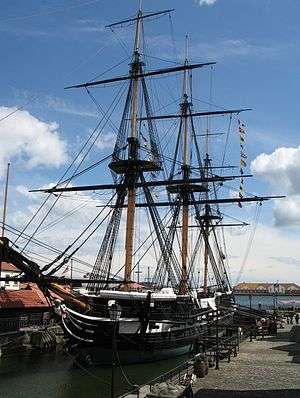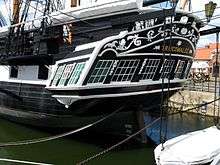HMS Trincomalee
 Trincomalee in her current location in Hartlepool | |
| History | |
|---|---|
| Name: | HMS Trincomalee |
| Operator: | Royal Navy |
| Ordered: | 30 October 1812 |
| Builder: | Bombay Dockyard |
| Laid down: | 25 April 1816 |
| Launched: | 12 October 1817 |
| Out of service: | 1986 |
| Renamed: |
|
| Status: | Museum ship, Hartlepool, England |
| General characteristics | |
| Class and type: | Leda-class frigate |
| Tons burthen: | 1065.63 bm |
| Length: |
|
| Beam: | 39 ft 11.25 in (12.1730 m) |
| Depth of hold: | 12 ft 9 in (3.89 m) |
| Sail plan: | Full-rigged ship |
| Complement: | 315 officers and men |
| Armament: |
|
HMS Trincomalee is a Royal Navy Leda-class sailing frigate built shortly after the end of the Napoleonic Wars. She is now restored as a museum ship in Hartlepool, England.
History
1812 - 1847
Trincomalee is one of two surviving British frigates of her era — her near-sister HMS Unicorn (of the modified Leda class) is now a museum ship in Dundee. After being ordered on 30 October 1812, Trincomalee was built in Bombay, India by the Wadia family [1] of shipwrights in teak, due to oak shortages in Britain as a result of shipbuilding drives for the Napoleonic Wars. The ship was named Trincomalee after the 1782 Battle of Trincomalee off the Ceylon (Sri Lanka) port of that name.
With a construction cost of £23,000, Trincomalee was launched on 12 October 1817. Captain Philip Henry sailed her to Portsmouth Dockyard where she arrived on 30 April 1819, with a journey costing £6,600.[2] During the maiden voyage the ship arrived at Saint Helena on 24 January 1819 where she stayed for 6 days, leaving with an additional passenger, a surgeon who had attended Napoleon at Longwood House on the island, Mr John Stokoe.[3]
After being fitted out at a further cost of £2,400, Trincomalee was placed in reserve until 1845, when she was re-armed with fewer guns giving greater firepower, had her stern reshaped and was reclassified as a sixth-rate spar-decked corvette.[4]
1847 - 1857
Trincomalee departed from Portsmouth in 1847 and remained in service for ten years, serving on the North American and West Indies station. During her time, she was to help quell riots in Haiti and stop a threatened invasion of Cuba, and serve on anti-slavery patrol. In 1849, she was despatched to Newfoundland and Labrador before being recalled to Britain in 1850. In 1852 she sailed to join the Pacific Squadron on the west coast of America.[5]
TS Foudroyant
Trincomalee finished her Royal Navy service as a training ship, but was placed in reserve again in 1895 and sold for scrap two years later on 19 May 1897. She was then purchased by entrepreneur George Wheatley Cobb, restored, and renamed Foudroyant in honour of HMS Foudroyant, his earlier ship that had been wrecked in 1897.[6]
She was used in conjunction with HMS Implacable as an accommodation ship, a training ship, and a holiday ship based in Falmouth then Portsmouth. She remained in service until 1986, after which she was again restored and renamed back to Trincomalee in 1992.[7]
Later years

Now listed as part of the National Historic Fleet, following her recent restoration Trincomalee has become the centrepiece of the historic dockyard museum in Hartlepool.
Trincomalee holds the distinction of being the oldest British warship still afloat[8] as HMS Victory, although 52 years her senior, is in dry dock.
Until his death in 1929, the Falmouth-based painter Henry Scott Tuke used the ship and its trainees as subject matter.
Gallery
See also
- HMS Victory - 18th century first rate ship of the line
- USS Constitution - 18th century US Navy frigate
- HMS Unicorn - a surviving sister ship
- Historical Maritime Society
- List of Royal Navy ships in the Pacific Northwest
References
- ↑ "The Wadias of India". zoroastrian.org.uk. Retrieved 25 July 2015.
- ↑ "Trincomalee Construction". HMS Trincomalee. The National Museum. Retrieved 25 July 2015.
- ↑ The Portsmouth Telegraph letter dated St. Helena Jan. 29, 1819
- ↑ "HMS Trincomalee - Royal Navy Service". HMS Trincomalee. The National Museum. Retrieved 25 July 2015.
- ↑ HMS Foudroyant
- ↑ "HMS Trincomalee - Training days as TS Foudroyant". HMS Trincomalee. The National Museum. Retrieved 25 July 2015.
- ↑ "Restoration and the present day". HMS Trincomalee. The National Museum. Retrieved 25 July 2015.
- ↑ "HMS Trincomalee - About us". HMS Trincomalee. The National Museum. Retrieved 25 July 2015.
Further reading
- Andrew Lambert - Trincomalee: the last of Nelson’s frigates, Chatham Publishing, 2002, ISBN 1-86176-186-4
External links
| Wikimedia Commons has media related to HMS Trincomalee (ship, 1817). |
- HMS Trincomalee official website
- The Friends of HMS Trincomalee website
- National Museum of the Royal Navy information sheet: HMS Foudroyant
- YouTube Channel Online video resource set up by Hartlepool College, which features short films about the history, culture and current activities of the town, including the Tall Ships Race 2010 and several featuring HMS Trincomalee
- The perfecting of the wooden man-of-war in the context of early 19th century international politics
- Current location on Wikimapia
- "Our treasure ship". gazettelive.co.uk
Coordinates: 54°41′25″N 1°12′24″W / 54.69028°N 1.20667°W



